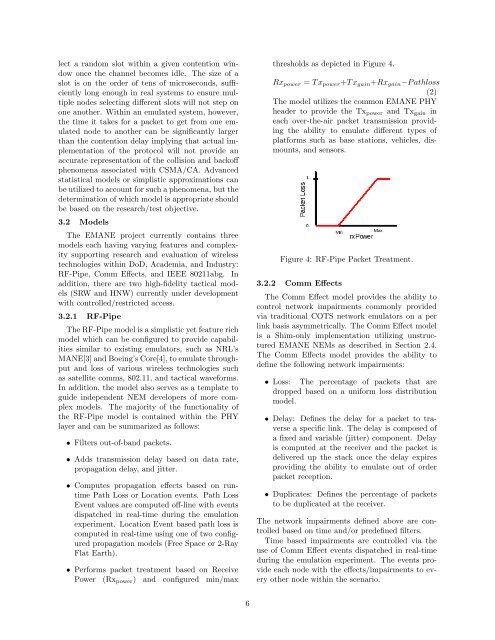Emulation Experimentation Using the Extendable Mobile Ad-hoc ...
Emulation Experimentation Using the Extendable Mobile Ad-hoc ...
Emulation Experimentation Using the Extendable Mobile Ad-hoc ...
Create successful ePaper yourself
Turn your PDF publications into a flip-book with our unique Google optimized e-Paper software.
lect a random slot within a given contention window<br />
once <strong>the</strong> channel becomes idle. The size of a<br />
slot is on <strong>the</strong> order of tens of microseconds, sufficiently<br />
long enough in real systems to ensure multiple<br />
nodes selecting different slots will not step on<br />
one ano<strong>the</strong>r. Within an emulated system, however,<br />
<strong>the</strong> time it takes for a packet to get from one emulated<br />
node to ano<strong>the</strong>r can be significantly larger<br />
than <strong>the</strong> contention delay implying that actual implementation<br />
of <strong>the</strong> protocol will not provide an<br />
accurate representation of <strong>the</strong> collision and backoff<br />
phenomena associated with CSMA/CA. <strong>Ad</strong>vanced<br />
statistical models or simplistic approximations can<br />
be utilized to account for such a phenomena, but <strong>the</strong><br />
determination of which model is appropriate should<br />
be based on <strong>the</strong> research/test objective.<br />
3.2 Models<br />
The EMANE project currently contains three<br />
models each having varying features and complexity<br />
supporting research and evaluation of wireless<br />
technologies within DoD, Academia, and Industry:<br />
RF-Pipe, Comm Effects, and IEEE 80211abg. In<br />
addition, <strong>the</strong>re are two high-fidelity tactical models<br />
(SRW and HNW) currently under development<br />
with controlled/restricted access.<br />
3.2.1 RF-Pipe<br />
The RF-Pipe model is a simplistic yet feature rich<br />
model which can be configured to provide capabilities<br />
similar to existing emulators, such as NRL’s<br />
MANE[3] and Boeing’s Core[4], to emulate throughput<br />
and loss of various wireless technologies such<br />
as satellite comms, 802.11, and tactical waveforms.<br />
In addition, <strong>the</strong> model also serves as a template to<br />
guide independent NEM developers of more complex<br />
models. The majority of <strong>the</strong> functionality of<br />
<strong>the</strong> RF-Pipe model is contained within <strong>the</strong> PHY<br />
layer and can be summarized as follows:<br />
• Filters out-of-band packets.<br />
• <strong>Ad</strong>ds transmission delay based on data rate,<br />
propagation delay, and jitter.<br />
• Computes propagation effects based on runtime<br />
Path Loss or Location events. Path Loss<br />
Event values are computed off-line with events<br />
dispatched in real-time during <strong>the</strong> emulation<br />
experiment. Location Event based path loss is<br />
computed in real-time using one of two configured<br />
propagation models (Free Space or 2-Ray<br />
Flat Earth).<br />
• Performs packet treatment based on Receive<br />
Power (Rxpower) and configured min/max<br />
6<br />
thresholds as depicted in Figure 4.<br />
Rxpower = T xpower+T xgain+Rxgain−P athloss<br />
(2)<br />
The model utilizes <strong>the</strong> common EMANE PHY<br />
header to provide <strong>the</strong> Txpower and Txgain in<br />
each over-<strong>the</strong>-air packet transmission providing<br />
<strong>the</strong> ability to emulate different types of<br />
platforms such as base stations, vehicles, dismounts,<br />
and sensors.<br />
Figure 4: RF-Pipe Packet Treatment.<br />
3.2.2 Comm Effects<br />
The Comm Effect model provides <strong>the</strong> ability to<br />
control network impairments commonly provided<br />
via traditional COTS network emulators on a per<br />
link basis asymmetrically. The Comm Effect model<br />
is a Shim-only implementation utilizing unstructured<br />
EMANE NEMs as described in Section 2.4.<br />
The Comm Effects model provides <strong>the</strong> ability to<br />
define <strong>the</strong> following network impairments:<br />
• Loss: The percentage of packets that are<br />
dropped based on a uniform loss distribution<br />
model.<br />
• Delay: Defines <strong>the</strong> delay for a packet to traverse<br />
a specific link. The delay is composed of<br />
a fixed and variable (jitter) component. Delay<br />
is computed at <strong>the</strong> receiver and <strong>the</strong> packet is<br />
delivered up <strong>the</strong> stack once <strong>the</strong> delay expires<br />
providing <strong>the</strong> ability to emulate out of order<br />
packet reception.<br />
• Duplicates: Defines <strong>the</strong> percentage of packets<br />
to be duplicated at <strong>the</strong> receiver.<br />
The network impairments defined above are controlled<br />
based on time and/or predefined filters.<br />
Time based impairments are controlled via <strong>the</strong><br />
use of Comm Effect events dispatched in real-time<br />
during <strong>the</strong> emulation experiment. The events provide<br />
each node with <strong>the</strong> effects/impairments to every<br />
o<strong>the</strong>r node within <strong>the</strong> scenario.


